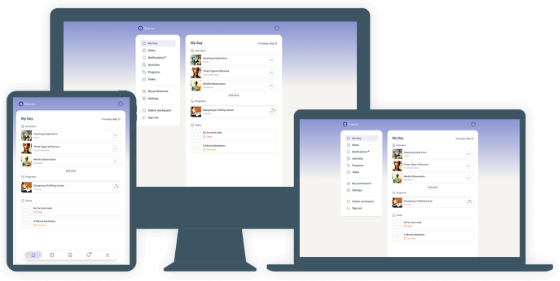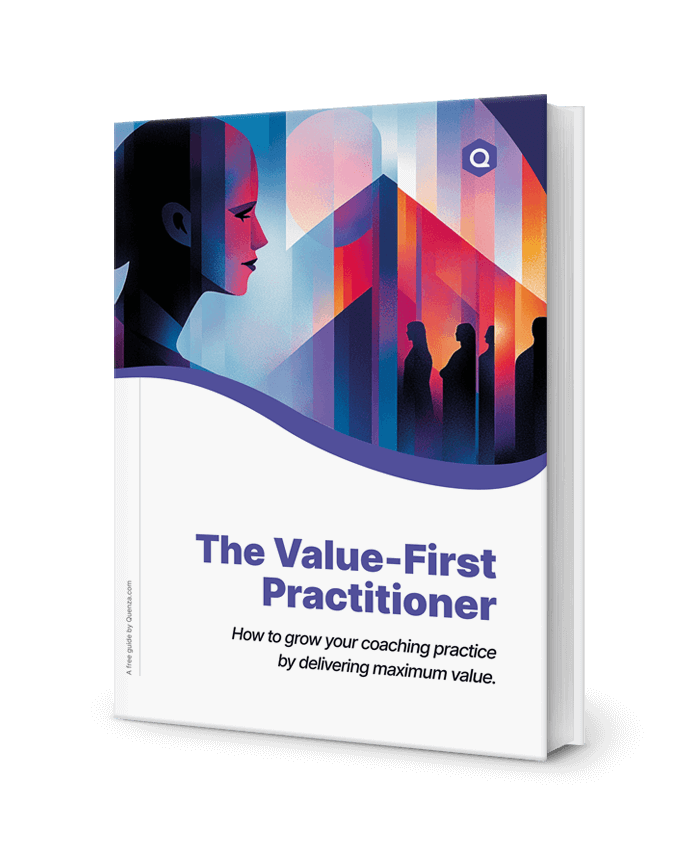In therapy, counseling, and medicine, clear and informative progress notes can avoid clinical errors and misunderstandings. Many different templates can help facilitate communication between busy providers, yield valuable insight, and streamline continuity of care – among them, BIRP Notes are one of the best-known formats.
This article will show you how to write effective, efficient BIRP notes using a variety of templates. Use these samples and your free Quenza trial to guide you in creating high-caliber progress notes and deliver even better, more professional therapy for those you help.
What Is a BIRP Note?
BIRP notes are mental health documents that professionals create to record a patient’s progress and treatment plan. The BIRP acronym refers to the four headers for each section: (B)ehavior, (I)ntervention, (R)esponse, and (P)lan.
The BIRP framework allows for efficient, accurate note-taking during or after sessions. It results in consistent formatting, allowing for easy and clear communication between a patient’s various healthcare providers.
How To Write Quick and Effective BIRP Notes
Using this format is a simple way to streamline your documentation.
Simply apply the BIRP structure by dividing a Progress Note into four sections:
- Behavior: Or a client’s presenting problem(s)
- Intervention: The techniques and methods applied, as well as the broader intervention categories that they fall into
- Response: How a patient or client responds to the therapy as a whole, the specific approaches used, and
- Plan: A framework for their treatment, addressing key goals and outcome objectives.
Following this format, which this article outlines in more detail, can greatly speed up the otherwise arduous documentation typically associated with clean, concise, and informative Progress Notes.
BIRP Notes Best Practice Checklist
When creating BIRP Notes manually or using clinical software, it’s useful to keep a few pointers in mind. Using industry best practice is a good way to ensure they serve their intended purpose as a communication tool between providers and that no important information is overlooked.
For example:
- BIRP Notes should link to a client’s personalized treatment plan, including their unique ID and name
- Regarding their therapeutic goals, their notes should consider a patient’s unique strengths and limitations
- As professional documents, they should be clearly written or typed, dated, and signed by the practitioner, and
- They should include standardized, consistent, and specialty-specific abbreviations where appropriate.
Using essential fields and drop-down menus, many therapy apps take care of these important details for practitioners – allowing them to focus on the content at hand. In a busy surgery or telehealth setting, the right software can sometimes be key to standardizing and streamlining BIRP notes within patient files.
BIRP notes are versatile and can be used for variety of applications and interventions. They can also be used at many stages of a patient’s treatment.
2 Useful Templates and Formats
Whether you’re a physical therapist, mental health coach, or online counselor, BIRP notes will likely have crossed your desk at some point. The BIRP format has a versatility that lends itself well to various applications and interventions and can be used at many stages of a patient’s treatment.
They may be used for:
- Management – e.g., Outlining different strategies and coping techniques in a pain management plan
- Skills-Building Interventions – In this context, they are commonly found in coaching interventions
- Evaluation – To assess and conclude a treatment’s efficacy, or
- Supporting documentation – Accompanying an insurance claim or in medical billing.
These templates all follow the standard Behavior, Intervention, Response, and Plan framework to demonstrate some of its many applications in practice.
In the next few sections, we’ll take a closer peek at the content of a BIRP note and what it should entail.
Standard BIRP Format
This standard BIRP format template can be used as a checklist for your progress notes. Each section details the key elements required for clear and exhaustive but concise documentation.[1]
|
BIRP Format Heading |
Details |
|---|---|
|
Behavior |
|
|
Intervention |
|
|
Response |
|
|
Plan |
|
BIRP Template for Counseling
In counseling, BIRP notes help maintain consistency when multiple organizations and providers collaborate as part of societal or community mental health programs.
California’s Solano County Mental Healthcare Network, for example, outlines a standardized BIRP template for behavioral health specialists such as clinicians and psychologists:[2]
- Behavior/Presenting Problem: Identifies long-term presenting problems and the patient’s current presentation that day to justify the medical necessity of the provided service. Here, the type of therapy and location of a session is also documented.
- Interventions: Capture specific interventions and their encompassing therapeutic modalities, such as supportive counseling or CBT. As with many other templates, clinicians are encouraged to use verbs to communicate actions to achieve a patient’s treatment goals.
- Response: For each intervention outlined, a response is included in this section. Under these sub-headings, responses from a patient or their support person can be detailed.
- Plan: Includes clear and specific goals that will comprise the next appointment’s foci. An outline for the follow-up session can be detailed here.
BIRP Notes Samples: 2 Practical Examples
Building on the Solano Mental Healthcare example, we can formulate a few practical examples.
Counseling Sample
In a counseling context, a BIRP notes sample for a patient with Generalized Anxiety Disorder might look as follows:
|
BIRP Format Heading |
Details |
|---|---|
|
Behavior | Visited patient at the Sunshine Community Clinic. Based on today’s psychological assessment, the patient has moderate symptoms of anxiety.Most recently, he demonstrated negative affect, and her movements were tense and shaky. He reported feeling frightened and exhausted all week and seemed aggravated while talking.
Patient reports that she has stopped taking the prescribed SSRIs. |
|
Intervention | Applying cognitive restructuring techniques, the practitioner reframed the patient’s concerns and modeled mental coping strategies for trigger events.The therapist also supported the patient through talk therapy, coaching him to rationalize his ‘worst case’ thinking patterns. Discussed client’s decision to cease medication and encouraged him to renew his prescription. Recommended that patient schedule a meeting with GP this week to discuss changing dosage.
Recommended that the client meets with her Psychiatrist as soon as possible to discuss his (patient’s) concerns about medication. |
|
Response | When confronted about SSRI cessation, patient responded by describing reluctance to refill prescription in person. Patient described fears about being judged by others at the clinic concerning requiring mental health treatment.When the appointment finished, the patient agreed to meet with his GP on Tuesday. |
|
Plan | Follow-up session scheduled on October 3rd.Goals include:
|
BIRP Notes Sample: ICANNotes Software
As many blended care professionals know, various great practice management systems offer BIRP note templates to speed up the process further.
ICANotes, for example, will integrate pre-written patient data into the Behavior, Intervention, Response, and Plan template along with ICD-10, DSM, or ICD codes.
As the sample below illustrates, therapists, counselors, and behavioral health specialists who work with a lot of clients can use the software to create brief in-session notes before centralizing them as a single patient file.

Watch the full ICANotes BIRP notes example here on Youtube.
5 Interventions To Consider For Your Notes
In counseling, BIRP notes help maintain consistency when multiple organizations and providers collaborate as part of societal or community mental health programs.
As mentioned earlier, the BIRP format is versatile. These standard and long-established progress notes lend themselves well to a range of general and mental health treatments in virtual, conventional, and blended care.
As such, they are frequently found in treatment plans that encompass interventions such as:
- Cognitive Behavioral Therapy (CBT) – e.g., in the mental health treatment of trauma, depression, phobias, or anxiety
- Speech Therapy – both in adult care and pediatric treatments
- Psychiatry – to consolidate medication-related and therapeutic treatments
- Occupational Therapy – such as in recovery from injury, and
- Physical Therapy – where they may include details of physical exercises and data from medical assessments.
Recommended: SOAP Notes: How a 50-Year-Old Format Stays Current in Medicine
The Role of Technology in Writing BIRP Notes
Incorporating technology into the process of writing BIRP notes can significantly enhance efficiency and accuracy. Many mental health professionals are now using electronic health records (EHR) systems, which streamline the documentation process.
These systems often come with templates and prompts that ensure all necessary information is captured consistently. Furthermore, using EHR systems can reduce the risk of losing important patient data, as everything is stored securely in the cloud.
Additionally, some EHR platforms offer voice-to-text features, allowing therapists to dictate their notes, which can be especially useful for those who find typing cumbersome or time-consuming. Leveraging technology not only saves time but also allows for better organization and retrieval of patient information, ultimately improving the quality of care provided.
Common Pitfalls to Avoid When Writing BIRP Notes
Despite their straightforward structure, BIRP notes can sometimes be challenging to write effectively. One common pitfall is being too vague in the documentation, which can lead to misinterpretations and gaps in patient care.
It’s crucial to provide specific details about the patient’s behavior and the interventions used, rather than using generic descriptions. Another issue is inconsistency in note-taking, where some sessions are documented in detail while others are not. Consistency is key to tracking progress and identifying patterns over time.
Additionally, therapists might sometimes neglect to update the plan section regularly, which is essential for outlining the next steps in treatment. By being mindful of these common pitfalls, mental health professionals can ensure their BIRP notes are both comprehensive and useful for ongoing patient care.
Final Thoughts
If you’re working in a multi-provider practice, or regularly collaborate with other practitioners, BIRP notes can be a handy tool. But what works for one organization may not for another – and so it’s good to have more than one framework to refer to.
Elsewhere on this site, you’ll find valuable information on how to write great SOAP Notes, and on the best all-around private practice software with in-built Progress Note-taking features. If you’ve found a great blended care solution for your practice needs, leave a comment, and share it with your peers.
We hope you enjoyed this article. To create your own BIRP notes using Quenza, make sure you start your free 1-month trial.
Quenza’s mental health and coaching toolkit contains everything you need to create HIPAA- and GDPR-compliant notes for all your sessions, fast and effectively from anywhere.
Frequently Asked Questions
The length of a BIRP note can vary depending on the complexity of the session and the client’s needs. Generally, a well-written BIRP note should be concise yet comprehensive, typically ranging from 200 to 500 words. The key is to include all relevant information without unnecessary details.
Yes, BIRP notes can be adapted for group therapy sessions. In this case, the Behavior section might include observations about group dynamics and individual participant behaviors. The Intervention section would detail the group activities or techniques used. The Response section would summarize both individual and collective responses, while the Plan would outline future group goals and individual follow-ups if necessary.
BIRP notes should ideally be written after each therapy session or client interaction. This ensures that all important details are captured while they’re fresh in the therapist’s mind. For ongoing treatments, it’s crucial to maintain consistent documentation to track progress effectively and maintain continuity of care.
Yes, there are several legal considerations. BIRP notes are legal documents and may be subpoenaed in court cases. They should be factual, objective, and free from personal opinions or judgments. It’s crucial to maintain client confidentiality and adhere to HIPAA regulations. Always include only relevant information and be mindful of the language used, as these notes may be read by the client or other professionals in the future.
To improve efficiency, consider using standardized templates or electronic health record (EHR) systems with built-in BIRP formats. Develop a set of commonly used phrases or abbreviations for recurring themes or interventions. Practice writing concise yet comprehensive notes, focusing on key information. Some therapists find it helpful to jot down brief notes during sessions and expand on them immediately after. Regular review and refinement of your note-taking process can also lead to improved efficiency over time.
References
- ^ ICANotes. (2020). Types of Notes Therapists Use and What Should Be Included. Retrieved from https://www.icanotes.com/online-guides/master-class-everything-therapists-need-to-know-about-creating-insurance-and-progress-notes-to-maximize-reimbursement-rates/chapter-3-types-of-notes-therapists-use-and-what-therapists-should-include-in-their-notes/
- ^ Solano Network of Care. (2012). Solano Network of Care Documentation Manual. Retrieved from: https://solano.networkofcare.org/content/client/357/Documentation-Manual-3rd-Edition-April-2012.pdf




This consistent method of writing notes is widely accepted for its standard format. This consistency makes the BIRP template an important resource for communicating client information with other healthcare providers.
Where would I be able to get samples of CPST notes? Birp notes samples